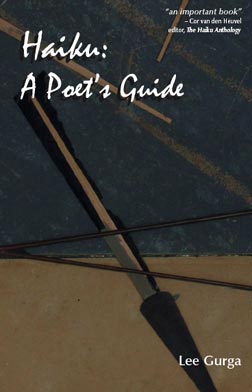Some Notes on Lee Gurga Haiku: A Poet's Guide
by J. Zimmerman
Notes on Lee Gurga's Haiku: A Poet's Guide (2003)
This is the most interesting and helpful book about writing haiku that I have read todate (2012).
Full of the history of haiku in both Japanese and English-language cultures,
Gurga's Haiku: A Poet's Guide shows the reader how to take
inspiration and word-sketching, create and revise a haiku, to attain
a poem's final version.
In addition to guidelines of what to do and what to avoid, Gurga gives the context
of haiku and their creation. He explores differences
and similarities between this English-language and the Japanese-language
haiku. The varied haiku examples enrich the book and inform the reader.
The book is not so much for the beginner poet but for someone that already considers herself
a poet, perhaps even a haiku poet.
As such, it is worth the time of the haiku poet to re-read Haiku: A Poet's Guide every few years.
Contents:
The book closes with Works Cited, Resources, Books, Credits, and an Index.
- Preface: An Introduction to Haiku
-
In his preface, Gurga extols haiku as
|
A poetry with the single aim of making us aware of life's simple gifts and
everyday joys ... An antidote to irony, consumerism, and narcissism
|
and he sets the scene for his project — to teach "what haiku is and what it is not".
Gurga emphasizes that: "haiku is informed by a set of aesthetic principles"
that supersede the form of "seventeen syllables, arranged in
three lines of five, seven, and five syllables".
- Haiku — The Poetry of the Seasons
Gurga states:
|
The essence of haiku resides, in part, in its ability, through the use of a seasonal image,
to convey some sense of the natural world and the passage of time.
|
He continues in this section to review the historical developments of Japanese and American haiku
traditions over the recent centuries.
- The Art of Haiku
This section concerns the tools to use and dimensions to consider in writing haiku:
- Form
- Season
- Haiku Moment, Context, and Order of Perception
- Juxtaposition and Working With Images
- Senses in Haiku
- Suggestion and Reverberation
- Significance and Effect
- Not Exactly Haiku: Senryu and Zappai
Gurga's differentiation of senryu from haiku is essentially [p. 55]:
|
Haiku relates nature to human nature,
while senryu is concerned with human nature pure and simple.
Senryu does not require a season word, and it relies on wit,
irony, and satire to comment on the human condition.
...
Lacking the haiku quality of growth that Henderson identified,
senryu is generally 'end-stopped.'
|
Gurga differentiates zappai from these as a genre dominated by
an imaginary element and that includes [pp. 57-58]:
|
verses in haiku-like forms, written purely as a joke.
...
If a short poem sounds like an aphorism, epigram, proverb, or fortune-cookie wisdom,
is is probably zappai.
|
- The Craft of Haiku
This section concerns haiku language and poetics:
- Language — straightforward and natural, with an avoidance of end-rhyme and light hand
on alliteration, a modest use of consonance and assonance, and a sensitivity to rhythm.
- Haiku on the Page
- Other Techniques of Japanese Haiku
- Haiku Grammar
- Poetic Devices
- Objectivity, Subjectivity, and Subjective Realism
- The Secret to Writing Haiku
- Getting in the Mood
- Writing and Revising Haiku
The begetting and improving of your haiku:
- Beginners' Haiku
- A Haiku Typology
- Why Edit?
- Guidelines for Editing
- Publishing Haiku
- Haiku Arts: Renku, Haibun, and Haiga
Discusses linked verse and the interweaving of prose and haiku (in a haibun)
and art and haiku (in a haiga).
- From Bashō to Barthes
- The Aesthetics of Classical Haiku
- Shiki: Three Stages in the Development of the Haiku Poet
- Barthes: Finding the Pleats in the Silk of Life
- From Nature Sketching to Worldless Poem
The book closes with a consideration of haiku's appeal and with a look to the future.
-
To order Modern Haiku.
Order Modern Haiku
(past editor Lee Gurga).
- Lee Gurga's Books on Haiku.
- Other Books on Haiku.
 [Thanks for visiting.]
[Thanks for visiting.]
 Toward an Aesthetic for English-Language Haiku by Lee Gurga.
Toward an Aesthetic for English-Language Haiku by Lee Gurga.
 Haiku: A Poet's Guide by Lee Gurga.
Haiku: A Poet's Guide by Lee Gurga.
 The Haiku Form by Joan Giroux.
The Haiku Form by Joan Giroux.
 2004 Pescadero Haiku Weekend Workshop (including exercises) with Christopher Herold.
2004 Pescadero Haiku Weekend Workshop (including exercises) with Christopher Herold.
 Review of Modern Haiku Volume 34.2 (2003).
Review of Modern Haiku Volume 34.2 (2003).
 Review of Modern Haiku: Robert Spiess Memorial Issue (2002).
Review of Modern Haiku: Robert Spiess Memorial Issue (2002).
 Join.
Join.
 GEPPO magazine.
GEPPO magazine.
 Annual anthologies.
Annual anthologies.
 2007 Asilomar Haiku Retreat.
2007 Asilomar Haiku Retreat.
 Index of Poetry.
Index of Poetry.
 Highlights for Poetry.
Highlights for Poetry.
 Books of Poetry Form.
Books of Poetry Form.
 How to Write Poetry.
How to Write Poetry.
 Haiku by Bashō.
Haiku by Bashō.
 Haiku by Shiki.
Haiku by Shiki.
 Haiku by J. Zimmerman.
Haiku by J. Zimmerman.





